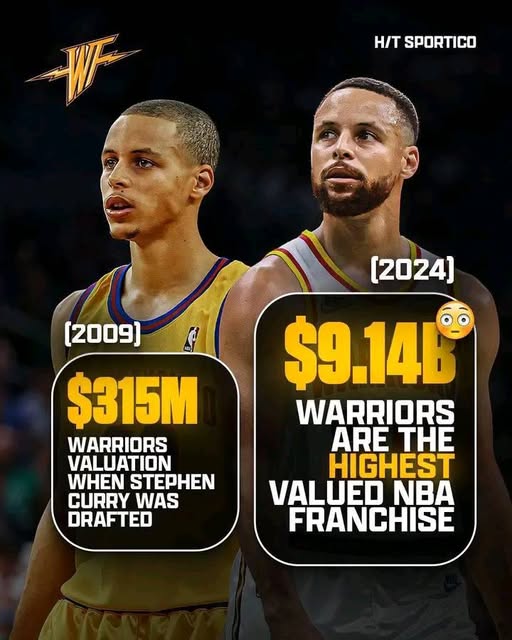Stephen Curry’s impact on the Golden State Warriors transcends basketball. When Curry entered the league in 2009, few could have predicted the seismic shift he would cause—not only in how the game is played but in the very identity, value, and global reach of the franchise. Over the years, Curry has become not just the face of the Warriors but the engine behind their transformation into a multi-billion-dollar powerhouse. His influence has been instrumental in reshaping team dynamics, altering business strategies, and redefining fan engagement in the modern NBA era.
Before Curry’s arrival, the Warriors were mired in mediocrity. Decades of underperformance had relegated the franchise to the fringes of relevance. They had made sporadic playoff appearances, but consistent success was elusive. The team cycled through coaches, struggled with front office instability, and had minimal national exposure. Located in the Bay Area—a region with immense potential but relatively untapped sports market influence—the Warriors were far from being a premier NBA destination. Then came Stephen Curry, the seventh overall pick in the 2009 NBA Draft, a skinny, unassuming guard from Davidson College whose shooting talent was undeniable but whose durability and size raised concerns.
Curry’s early years were marked by ankle injuries, and the franchise’s future with him seemed uncertain. However, in a move that would later become one of the most cost-effective contracts in NBA history, the Warriors signed Curry to a four-year, \$44 million extension in 2012, betting on his potential rather than his injury history. That decision gave the team the flexibility to build around him, setting the stage for an unprecedented transformation.
As Curry’s health stabilized, his game evolved dramatically. He didn’t just improve; he revolutionized basketball. Curry stretched defenses to their limits with his deep three-point shooting, quick release, and off-ball movement. His style of play forced teams to rethink their defensive strategies. Suddenly, three-point shooting wasn’t a luxury; it was a necessity. Curry’s influence on the court rippled across the league, leading to a new era of pace-and-space basketball. But while he was changing the game on the hardwood, he was also reshaping the Golden State Warriors’ brand, marketability, and bottom line.
The Warriors’ front office recognized what they had in Curry—not just a superstar, but a transformative figure around whom they could build a cultural and commercial empire. Under the ownership of Joe Lacob and Peter Guber, the franchise underwent a strategic overhaul. They invested in analytics, embraced innovation, and prioritized player development. Curry’s ascension was the linchpin of this new era. His selfless demeanor, work ethic, and charisma resonated with fans and sponsors alike. He became the NBA’s most relatable superstar—humble, family-oriented, and extraordinarily skilled.
The results were astounding. On the court, the Warriors morphed into a dynasty. Starting in 2015, the team reached five consecutive NBA Finals, winning three championships. These victories significantly raised the franchise’s profile and established it as a global brand. Merchandise sales soared, television ratings climbed, and the team became appointment viewing not just in California but around the world. Curry’s jersey consistently ranked among the league’s top sellers, and his presence turned casual viewers into dedicated fans.
Off the court, the Warriors capitalized on their success by turning themselves into a modern sports business juggernaut. They leveraged Curry’s appeal to ink major sponsorship deals, grow their digital footprint, and expand their fan base globally. The franchise embraced social media, streaming content, and international marketing strategies that were tailor-made for a new generation of fans. Curry’s highlights were tailor-made for the viral era—deep threes, no-look passes, and signature celebrations that became meme-worthy content overnight.
Perhaps the most symbolic indicator of the Warriors’ transformation was the opening of the Chase Center in 2019. This state-of-the-art arena in San Francisco’s Mission Bay district represented the culmination of a decade-long journey. Built with private financing and valued at over \$1 billion, the Chase Center was more than just a venue for basketball games—it was a sports and entertainment complex designed to be a year-round destination. Curry’s rise made such a bold move viable. Without his star power and the team’s championship pedigree, the risk of moving the franchise from Oakland to a more upscale, high-cost location might have been untenable.
Curry’s impact also extended into the business community. Tech giants from Silicon Valley took notice of the Warriors, forming partnerships and collaborating on projects. The franchise’s proximity to Silicon Valley, coupled with Curry’s clean image and mass appeal, made the Warriors a favorite for investors and sponsors alike. From Rakuten to Oracle to Biofreeze, companies lined up to associate their brands with the team, and Curry was the focal point of many of those campaigns.
Financially, the results were staggering. According to Forbes, the Warriors’ valuation skyrocketed from under \$450 million in 2010 to over \$7 billion by 2024, making them the most valuable team in the NBA. Revenue streams diversified far beyond ticket sales: licensing, streaming, merchandising, and real estate all contributed to the bottom line. Curry, in essence, had become the face of a billion-dollar enterprise.
But numbers alone don’t capture the full scope of Curry’s influence. Culturally, he redefined what it means to be a superstar. In an era where athletes often feel pressure to project a certain image, Curry stayed true to himself. He didn’t rely on bravado or controversy to stay in the spotlight. His authenticity resonated with fans across demographics, making him an icon in both urban and suburban markets. His popularity crossed borders and oceans, turning him into a global ambassador for the game.
Moreover, his leadership created a positive and cohesive team culture. Curry’s unselfishness set the tone for the Warriors’ style of play and locker room dynamics. When Kevin Durant joined the team in 2016, it was Curry’s willingness to share the spotlight that made the transition seamless. That humility is rare among superstars and became a defining trait of the Warriors’ dynasty years. It helped the franchise maintain a consistent identity even as the roster evolved.
Even during downturns—such as injuries, roster changes, and a two-year playoff drought—Curry’s presence ensured that the Warriors remained relevant and commercially viable. In the 2020-2021 season, as he carried a depleted roster and still led the league in scoring at age 33, fans and analysts alike marveled at his longevity and dedication. Curry proved that he wasn’t just a flash in the pan but a cornerstone athlete who could sustain excellence and excitement over the long term.
The broader impact of Curry’s rise is still being felt across the league. Youth basketball has seen a shift, with kids emulating his deep shooting and ball-handling skills. Camps and academies now emphasize three-point shooting and movement off the ball, skills that were once considered secondary. High school and college programs have evolved, and the NBA itself has seen a dramatic increase in three-point attempts, largely because of the paradigm Curry introduced.
Stephen Curry didn’t just make the Golden State Warriors great; he made them matter. He elevated them from obscurity to the pinnacle of global sports, crafting a legacy that goes beyond titles and MVP trophies. Through his play, personality, and leadership, he turned a once-middling franchise into a billion-dollar powerhouse and helped usher in a new era for the NBA. The story of the Warriors’ rise cannot be told without Stephen Curry at its center. He is the foundation, the spark, and the soul of a transformation that redefined what success in professional sports can look like.



